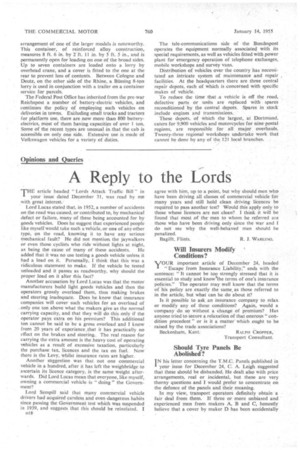Post Office the ackbone of German Transport
Page 56

Page 57

Page 58

If you've noticed an error in this article please click here to report it so we can fix it.
By W. H. Godwin
THE Federal Post Office (Deutsche Bundespost) is playing an important part in the bitter struggle betiveen road and rail in Western Germany. In addition to its primary function of carrying mails, it is also the largest operator of public service vehicles in the country, and in this role has managed to "maintain a high standard of service in the face of adverse conditions.
Since 1947, when 85m. passengers were carried on 970 routes—a reflection on the chaotic post-war state of other means for public transport—the number of passengers carried annually has almost trebled, and the number of routes increased to over 1,600. Today, the route mileage of the Bundespost is 25,500, and nearly 4,000 buses and coaches and over 400 passenger-carrying trailers, as well as some 10,000 vans, lorriet, specialpurpose vehicles and cars, are operated.
This year, the 50th anniversary of the introduction of motor vehicles on mail routes will be celebrated. In 1905, the first regular routes were opened by the Royal Bavarian Postal authorities, who were the country's leading advocates of mechanical transport. Nine years later, services operated by the Post Office equalled the combined route mileage of all other operators. In 1938, the last full year of operation before the late war. 58m. passengers were carried on 1,490 routes in the area which is now the Federal Republic.
One of the most interesting of the special-purpose n16 vehicles is a 35-cwt. van used for collection and delivery work in rural areas, for it can also carry up to four fare-paying passengers. Several hundred of these, based on Opel-Blitz chassis, serve remote communities to which there is no rail .communication.
Time-tables of post-bus routes are contained in a 1,600-page volume published twice a year, and which, in recognition a the importance of the foreign visitor— and possibly the occupying Forces—has introductory pages in three languages. The standard fare is six pfennigs per kilometre (equal to a little over id, \per mile), but on certain routes, • especially in the Black Forest and the Baiarian Alps, a slightly higher rate is applied. More than half of all passengers are now carried at concession rates, of which those applicable to scholars and apprentices, allowing a 70 per cent. reduction, are noteworthy.
Apart from the regular services, on which mail is carried either on the vehicle or in a two-wheeled trailer, the buses are also available for a limited amount of private-hire and tour work. Conversely, the Bundespost may hire vehicles from other operators for peak periods and, in a few instances, has routes which are operated under contract by private firms.
Joint working is operative in some parts Of Germany; in the north there are two cross-frontier routes shared with the Danish State Railways Motor Services. The Post Office is also responsible for Maintaining services in the Saar, and there are several routes projecting-into Austria.
Many of the modern vehicles in the fleet are M.A.N., Krauss-Maffei or .Mercedes standard Models with certain adaptations for postal duties. These include bodies with large roof-racks, trailer Couplings, and often post bexes for people living in remote districts. Last year, a number of lightweight buses of Rathgeber integral Construction was intr.bdiaced for some of the shorter routes. These have Krauss:Maffei engine and running components. The latest long-distance bus is based on the rear-engined Mercedes 6600 chassis, and is in service with a number of different seating layontS. .
There is a number of areas in Which; because Of unsuitable rail connections, Mail is carried throughout by road. On these routes, the use of specially designed containers ensures the most economical use of vehicles. This method is becoming more popular, and is also applied to the transfer of mail between city offices.
Various types of container have been evolved, and the arrangement of one of the larger models is noteworthy. This container, of reinforced alloy construction, measures 8 ft. 6 in. by 2 ft. 11 in. by 5 ft. 5 in., and is permanently open for loading on one of the broad sides. Up to seven containers are loaded onto a lorry by overhead crane, and a cover is fitted to the one at the rear to prevent loss of contents. Between Cologne and Deutz, on the other side of the Rhine, a Missing 8-ton lorry is used in conjunction with a trailer on a container service for parcels.
The Federal Post Office has inherited from the pre-war Reichspost a number of battery-electric vehicles, and continues the policy of employing such vehicles on deliveries in towns. ExChiding small trucks and tractors for platform use, there are now more than 800 batteryelectrics, most of them having capacities of over 1 ton. Some of the recent types are unusual in-that the cab is accessible on only one side. Extensive use is made of Volkswagen vehicles for a variety of duties. The tele-communications side of the Bundespost operates the equipment normally associated with its special requirements, as well as vehicles fitted with power plant for emergency operation of telephone exchanges, mobile workshops and survey vans.
Distribution of vehicles over the country has necessitated an intricate system of maintenance and repair facilities. At the headquarters there are three central repair depots, each of which is .concerned with specific makes of vehicle.
To reduce the time that a vehicle is off the road, defective parts or units are replaced with spares reconditioned by the central depots. Spares in stock include engines and transmissions.
These depots, of which the largest, at Dortmund, caters for 9,900 vehicles and motorcycles for nine-postal regions, are responsible for all major overhauls. Twenty-three regional workshops undertake work that cannot he done by any of the 121 local branches.
















































































































